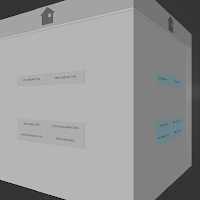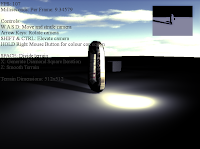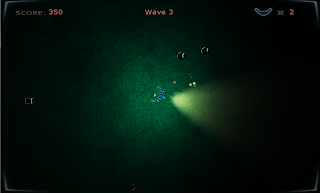3D Civilisation
I decided to give myself a project over the holidays to keep my brain active. I've always wanted to make some sort of civilisation simulator so decided now was a good time to start it. This isn't exactly a game and it's not something I am planning on publishing or anything, just trying to simulate a group of people surviving, generating food, building houses. The player may join in with the world but will have as much impact as the AI characters. I'm hoping this will turn into a nice summary of everything I've learned at MDS so far, with AI, rendering techniques I didn't get to try out during class and perhaps some multithreading to increase the performance of the AI. We'll see how it goes...
The aim of this is to get AI that will make decisions by itself based on what it decides is best for the state of the village, instead of having a fixed set of commands or particular state.
Started building this using the OpenGL framework but have switched to DirectX again now.
So far I have only really been focusing on rendering techniques. The AI currently just moves to random waypoints and avoids obstacles. Skeletal Animation of my chickens is nearly complete, using Assimp, however some vertices are still flying off to infinity.
Christmas Update
I've changed all of the 2D billboard sprites into 3D models, still just chickens, humans and trees. Since week 01 I've mainly just been working on changing my DirectX framework to be more like my OpenGL one, as I much prefer that framework. I've changed the pipeline to suit a deferred shading pipeline. Deferred lighting is now working really well, although I'm not yet rendering the lights to a texture as objects. Once this is done the performance will be much better. I've recently also added grass to the terrain using the Geometry Shader. This turned out to be much more efficient than I thought it would be. I'm currently rendering 250,000 grass blades at a time and maintaining a decent framerate. Will switch to developing on my laptop from now on in order to optimise the game for that.
Start of Production
Currently featuring a couple of humans and their chickens, in a spiral forest.
Below are some screenshots of the state of the framework so far.
______________________________________________________________________________
The aim of this is to get AI that will make decisions by itself based on what it decides is best for the state of the village, instead of having a fixed set of commands or particular state.
Started building this using the OpenGL framework but have switched to DirectX again now.
So far I have only really been focusing on rendering techniques. The AI currently just moves to random waypoints and avoids obstacles. Skeletal Animation of my chickens is nearly complete, using Assimp, however some vertices are still flying off to infinity.
Christmas Update
I've changed all of the 2D billboard sprites into 3D models, still just chickens, humans and trees. Since week 01 I've mainly just been working on changing my DirectX framework to be more like my OpenGL one, as I much prefer that framework. I've changed the pipeline to suit a deferred shading pipeline. Deferred lighting is now working really well, although I'm not yet rendering the lights to a texture as objects. Once this is done the performance will be much better. I've recently also added grass to the terrain using the Geometry Shader. This turned out to be much more efficient than I thought it would be. I'm currently rendering 250,000 grass blades at a time and maintaining a decent framerate. Will switch to developing on my laptop from now on in order to optimise the game for that.
Start of Production
Currently featuring a couple of humans and their chickens, in a spiral forest.
Below are some screenshots of the state of the framework so far.
 |
| Added lighting and radial blur |
______________________________________________________________________________
OpenGL Renderer
Started working on an OpenGL Renderer using Glew to handle the extension libraries for me.
Used this framework for the cloth simulation summative for Media Design School.
Got some inspiration while playing Arma 3 to try turning my OpenGL framework into some sort of flight simulator. Obviously nothing like Arma but it gave me a purpose and target to work towards with this framework, so decided to make use of my OBJ reader and imported a REALLY ROUGH helicopter and fixed wing model. Both the fixed wing and helicopter can fly at the moment but they require a lot more work. It's pretty horrible at the moment.
Used this framework for the cloth simulation summative for Media Design School.
Got some inspiration while playing Arma 3 to try turning my OpenGL framework into some sort of flight simulator. Obviously nothing like Arma but it gave me a purpose and target to work towards with this framework, so decided to make use of my OBJ reader and imported a REALLY ROUGH helicopter and fixed wing model. Both the fixed wing and helicopter can fly at the moment but they require a lot more work. It's pretty horrible at the moment.
 |
| 3rd Person cam |
 |
| Fixed wing cockpit |
 |
| Added "head" rotation independent of ship rotation |


















































